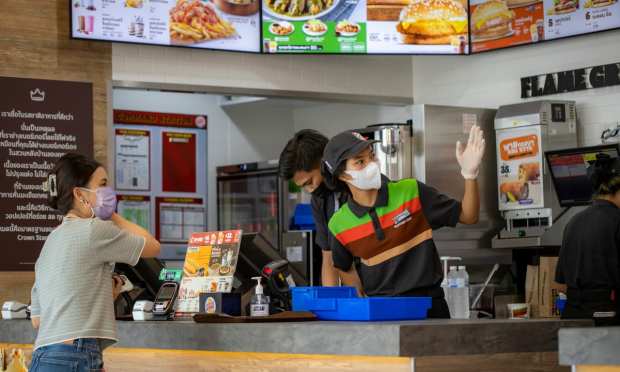Brightloom CEO Says Smart Segmentation Can Boost Restaurants’ ‘Most Important KPI’

For all restaurants, recovery from the devastating effects of the COVID-19 pandemic has been an uphill battle. However, not every restaurant’s hill has been equally steep. Restaurants that were able to take advantage of the accelerated digital shift to eCommerce brought on by the pandemic have had the opportunity to build online relationships with their customers that could drive loyalty and growth for years to come — if these restaurants can leverage the wealth of customer information at their disposal in the right ways.
“[Customers are] primarily expecting to have an online ordering experience and to have a digital relationship with the brand,” Adam Brotman, CEO of customer growth platform (CGP) Brightloom, told Karen Webster in a recent conversation. “So marketing, ordering and even pickup and fulfillment have all changed to being — where digital was sort of a bolt-on, now digital is the primary relationship. Digital is the primary way customers order.”
After the launch of Brightloom’s CGP in February, the company announced Thursday (July 15) that it had signed major restaurant brands Ruby Tuesday, El Pollo Loco and Cactus. They join the company’s existing list of customers, which includes Evergreens and Jamba. By leveraging customer data, the company’s solution so far has been lifting revenue per guest by mid-single digits and has increased customer reactivation by 12.6 percent.
Get Smart
Digital ordering is here to stay. PYMNTS research finds that two-thirds of consumers are now ordering restaurant meals for home and these customers are 31 percent more likely to order for off-premises consumption than on-premises. This shift from at-home consumption being the exception to being the norm requires restaurants to reconsider operations to meet the needs of today’s consumers.
“Brands are having to think in a much more multidisciplinary fashion,” said Brotman. “Restaurant brands are having to be like retailers had to become a couple years ago. They have to become omnichannel. They have to think about multiple different ordering points and multiple different pickup experiences.”
He added that this shift challenges restaurants to “become much more analytical.” Rather than relying on an age-old business model that has always brought in customers, restaurants are called upon to use the information at their disposal in new, data-backed ways to meet consumers where they are. After all, while the pandemic may have supercharged eCommerce adoption, getting users on the platform is only the first step.
Brotman noted that Brightloom chose to focus on an area that is particularly challenging for new digital brands: conversion to growth. “How do you convert all that surface area with your customers, in terms of digital relationships and all the data that’s coming from [the digital platform], to create this customer growth and activation engine?”
The company’s approach, Brotman said, works best for mid-size restaurant chains, defined broadly — brands with anywhere between 10 and 700 locations. These restaurants are large enough to have many customers on their digital platforms, and many of them are looking for solutions that will take them to the next step.
Different Strokes For Different Folks
By getting a deeper picture of how different consumers behave, brands can target their base in increasingly specific ways. One meaningful way a restaurant can learn about its customers’ behavior is by guiding customers’ to its ordering platform rather than third-party marketplaces. While the latter can bring in new customers and increase sales, these aggregators own the transaction, meaning that the restaurant sacrifices the opportunity to gain customer data.
With the restaurants’ data, Brightloom uses artificial intelligence to create “smart segments.” Brotman said, “each of those smart segments is composed of customers that our predictive models, our AI says, ‘These customers, they’re going to think and want similar things.’”
One of the key ways to segment is in terms of customer frequency. After all, the kinds of communications and offers that will succeed at bringing devoted fans back to the restaurant’s ordering channels are very different from those that will appeal to someone who has not ordered from the restaurant in months. Appealing to the latter category is especially important to many restaurant brands.
Citing his previous experience as a chief digital officer and then executive vice president of global retail operations at Starbucks and as president and co-CEO at J.Crew, Brotman said, “brands get really excited, as you can imagine, about when we can add to their active customer count. … I’ve learned [throughout my] career that the number one most important KPI for you as a retailer or a restaurant operator or marketer is the number of active digital customers … It’s the biggest leading indicator of how your business is going to do.”
Always Be Closing
As Brightloom sees it, the best way to keep customers active is by continually nudging them.
“If you’re going to send model-driven, personalized content to your customers, you want to do it on an always-on basis,” Brotman said, adding that when an offer is relevant enough, customers enjoy receiving it.
Additionally, he said, the more a brand messages a customer, the more information it can collect about the messages’ effectiveness and its customers, leading to smarter communications in the future. These activations to bring customers back in the doors (literally or digitally) are especially important for restaurants. Unlike retailers, revenue comes less from order size and more from order frequency.
“So by constantly running these messages, you’re getting overall better results,” he said. “You’re keeping your customers more engaged, and we and the brand are learning from what’s working. We’re able to optimize and even improve the results more and more over time.”
